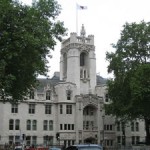Share it
 As part of our analysis of the UKSC’s first year, we’re taking a more detailed look at some of the aspects of the Court’s annual report – starting with section 4, Appointment of Justices. The procedure for appointing a Supreme Court Justice is governed by ss 25–31 of, and Sch 8 to, the Constitutional Reform Act 2005.
As part of our analysis of the UKSC’s first year, we’re taking a more detailed look at some of the aspects of the Court’s annual report – starting with section 4, Appointment of Justices. The procedure for appointing a Supreme Court Justice is governed by ss 25–31 of, and Sch 8 to, the Constitutional Reform Act 2005.
The appointments process in the 2005 Act was a substantial change from the previous system of appointment of Lords of Appeal in Ordinary. Such were appointed by the Queen on the recommendation of the Prime Minister, acting on the advice of the Lord Chancellor.
The 2005 Act sets out the statutory qualifications for appointment in s 25. An applicant must have held “high judicial office” for at least two years, or have been a solicitor or barrister for at least 15 years, who has been “gaining experience in law” during the post-qualification period. The establishment of a selection commission to fill a vacancy is set out in s 26, and s 27 determines the process, including the relatively extensive list of people who have to be consulted before a section can be made. All this is outlined in this section of the Court’s annual report. However, what the report doesn’t mention is the role of the Lord Chancellor, under ss 29–31, to reject or order the reconsideration of the selection made. Also missing from this description is the ostensible power of the Prime Minister under s 26 to make the recommendation to the Queen for appointment.
The annual report notes that the appointment of the 12th justice earlier in the year “was the first time a statutory selection process was used since the Constitutional Reform Act had come into force”. The previous occasion was on a voluntary basis prior to the establishment of the Court.
However, that appointment led to a certain amount of press speculation about the potential candidates for appointment, and the process itself. Ultimately, Sir John Dyson was appointed after some six months. The Court’s report itself notes that the process is a “lengthy one”, suggesting that one of the reasons in this instance was because of “adverse weather conditions disrupting planned interviews”.
The role of the Lord Chancellor in judicial appointments (including those for Supreme Court Justices) is interesting. The Explanatory notes to the 2005 Act explain that it “seeks to make a distinct constitutional separation between the legislature and the judiciary”. The 2007 Green Paper, Governance of Britain – Judicial Appointments, claimed that “the executive’s role in judicial appointments is now more limited than ever before.” Under the 2005 Act procedure, if the Lord Chancellor rejects a selection, or requests a reconsideration, he must give his reasons in writing, and only then for specified reasons. However, there is still a significant amount of discretion open the Lord Chancellor, who is ultimately a political appointment. As stated in the Commons’ Constitutional Affairs Report, Judicial appointments
and a Supreme Court (court of final appeal): “the balance of democratic accountability for judicial appointments and judicial independence is hard to strike.”
Section 5 of the Court’s report is entitled Transparency and openness, and the Court is rightly proud of the changes made to “create opportunities for people to gain a better understanding of the UK’s highest court and the UK’s legal systems in general”. However, it’s arguable that a more in-depth examination of the executive’s judicial appointments by Parliament might better fit this commitment to transparency.
At para 3.19 of the 2007 Green Paper it’s noted that:
“Parliament has historically had no role in the appointment of judges and this remains the case under the [2005 Act]. This is in contrast to the position in some other jurisdictions (see paras 3.24 to 3.28 below), where the power of appointment is in some way shared between the executive and legislature, most notably the United States as part of its system of checks and balances, where appointments by the President to the Supreme Court are subject to the “advice and consent” of the Senate.”
That said, as experience in those other jurisdictions shows, legislative involvement risks overtly politicising the decision-making process. And in any event, there is no groundswell of support for reform of this type of executive involvement. Of the 34 responses to the Green Paper mentioned above, “Most respondents did not consider the legislature should have a role, although most respondents did feel there should be a check on selections made by the Judicial Appointments Commission”. Reform of the judicial appointments process also doesn’t seem to be on the agenda of the Coalition Government’s reform plans.
Given Lord Saville’s announcement that he will retire, we will see the second application of this process in due course.
The Court’s Annual Report promises a review of the process, “during the next financial year” by the Chief Executive, reporting to the President of the Court, taking into account the recommendations of the panel on judicial diversity.


